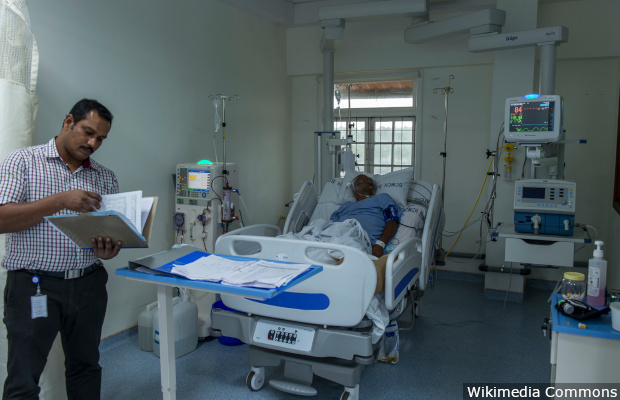New Delhi: Cardiac ailments killed more Indians in 2016 (28%) than any other non-communicable disease, said a new study published in the September 2018 issue of health journal The Lancet. These are double the numbers reported in 1990 when heart disease caused 15% of deaths in India.

Deaths due to cardiovascular diseases in India increased from 1.3 million in 1990 to 2.8 million in 2016, and more than half the deaths caused by heart ailments in 2016 were in persons less than 70 years of age, according to the study, ‘The Changing Patterns of Cardiovascular Diseases and Their Risk Factors in the States of India: the Global burden of Disease Study 1990-2016’.
Cardiovascular diseases are a collective of various kinds of heart ailments, stroke and diseases of blood vessels nourishing the limbs. Of them, coronary artery disease, also called ischemic heart disease–symptomised by the hardening of arteries–and strokes account for most deaths.
Ischemic heart disease caused 17.8% of deaths and strokes caused 7.1%, according to the study. Rheumatic heart disease, caused by acute rheumatic fever, now bears a lower disease burden in India: It causes 1.1% of total deaths. But India still contributes to 38% of its global disease burden, according to the study.
The number of people affected by cardiac diseases has doubled, the study estimated. About 54.5 million people were affected by the disease in 2016 compared to 25.7 million in 1990. Hardening of arteries was more common in men than women while strokes affect both sexes equally.
The study, which documented trends in cardiovascular disease in each Indian state over 25 years, described heart disease as “a major public health problem leading to premature deaths and disease across the states of India’’.
A critical issue highlighted by the scholars, as we discuss below, is that even states where cardiac disease has low prevalence–mostly less developed ones such as Bihar and Chhattisgarh–are now reporting higher instances of risk factors. This indicates the need for policy intervention, said the authors of the study.
Bad food, BP, air pollution, high cholesterol and tobacco: Biggest factors
Dorairaj Prabhakaran, cardiologist at the Public Health Foundation of India (PHFI), an advocacy, and the lead author of the paper, put this cardiac disease crisis down to unhealthy diet, hypertension, high cholesterol, diabetes, obesity and air pollution.
Among these, five are major risk factors: Bad food habits (54.4%), hypertension (56.6%), air pollution (31%), high cholesterol (29.4%) and tobacco usage (18.9%). Among tobacco users, in 83% smoking was seen as a major risk. However, researchers observed a decline in smoking habits in all states. In most cases, the various factors overlapped.
The prevalence of cardiovascular disease in 2016 was the highest in Kerala, Punjab and Tamil Nadu–more than 5,000 per population of 100,000. Andhra Pradesh, Himachal Pradesh, Maharashtra, Goa and West Bengal are close second with prevalence between 4,500 and 4,999 per 100,000.
Wealthier and more urbanised states in India deal with higher risk of heart disease, said a June 2018 study by the PHFI and the Harvard T H Chan School of Public Health.
Cardiac risk increased with increase in wealth, particularly in rural areas, this study found. In rural areas, those living in the wealthiest 20% districts were associated with a relative increase in the 10-year cardiac risk by 13.1% compared to the poorest 20% districts. In urban areas, the corresponding increase was 4.3%.
As incomes rose over the last 26 years, India’s burden of disease shifted: More deaths in India (61.8%) in 2016 were due to non-communicable diseases such as cardiovascular diseases and chronic obstructive pulmonary disease, while in 1990 more deaths (53.6%) were due to communicable, maternal, neonatal and nutritional (CMMND) diseases, according to a November 2017 study published in the medical journal Lancet.
Risk factors rise even in states with low burden of cardiac disease
The risk factors rose across all states between 1990 and 2016. In less developed states, the prevalence of the cardiac diseases was less: In Bihar, Jharkhand, Uttar Pradesh, Rajasthan, Meghalaya, Assam, Chhattisgarh, Madhya Pradesh and Odisha, the prevalence of the disease varied between 3,000 and 4,000 per 1,000,000 population. But the risk factors increased significantly compared to 1990. The disease burden has also increased about 15% in these states in recent years.
The authors have recommended immediate policy action to control the increasing prevalence of ischemic heart disease, stroke and their risk factors in all states of India, with particular attention to these less advanced states. It is possible to do this by providing better primary care and financial protection under Ayushman Bharat, the national health protection scheme which aims to provide health cover over to 100 million poor and vulnerable families.
How can cardiac disease be tackled as public health crisis? By strengthening primary care through health and wellness centres, starting appropriate referral linkages with secondary and tertiary levels of health care, starting multi-sectoral collaborations to reduce fat, salt and sugar consumption, reducing air pollution, sustaining the anti-smoking campaign and constant surveillance, said Prabhakaran.
The study is a part of State-Level Disease Burden Initiative, a project run jointly by the Indian Council of Medical Research, PHFI, and the Institute for Health Metrics and Evaluation in collaboration with the ministry of health and family welfare. It also involves experts and stakeholders associated in over 100 Indian institutions.
The collaboration resulted in a comprehensive analysis of several major non-communicable diseases and suicide numbers for every state in India based on analysis of all identifiable epidemiological data since 1990 as part of the Global Burden of Disease study. These findings have been reported in a series of five research papers published in The Lancet Global Health, The Lancet Public Health, and The Lancet Oncology, along with a commentary in The Lancet.
(Rashid is senior manager, external communication and digital media, at the Public Health Foundation of India.)
Courtesy: India Spend
